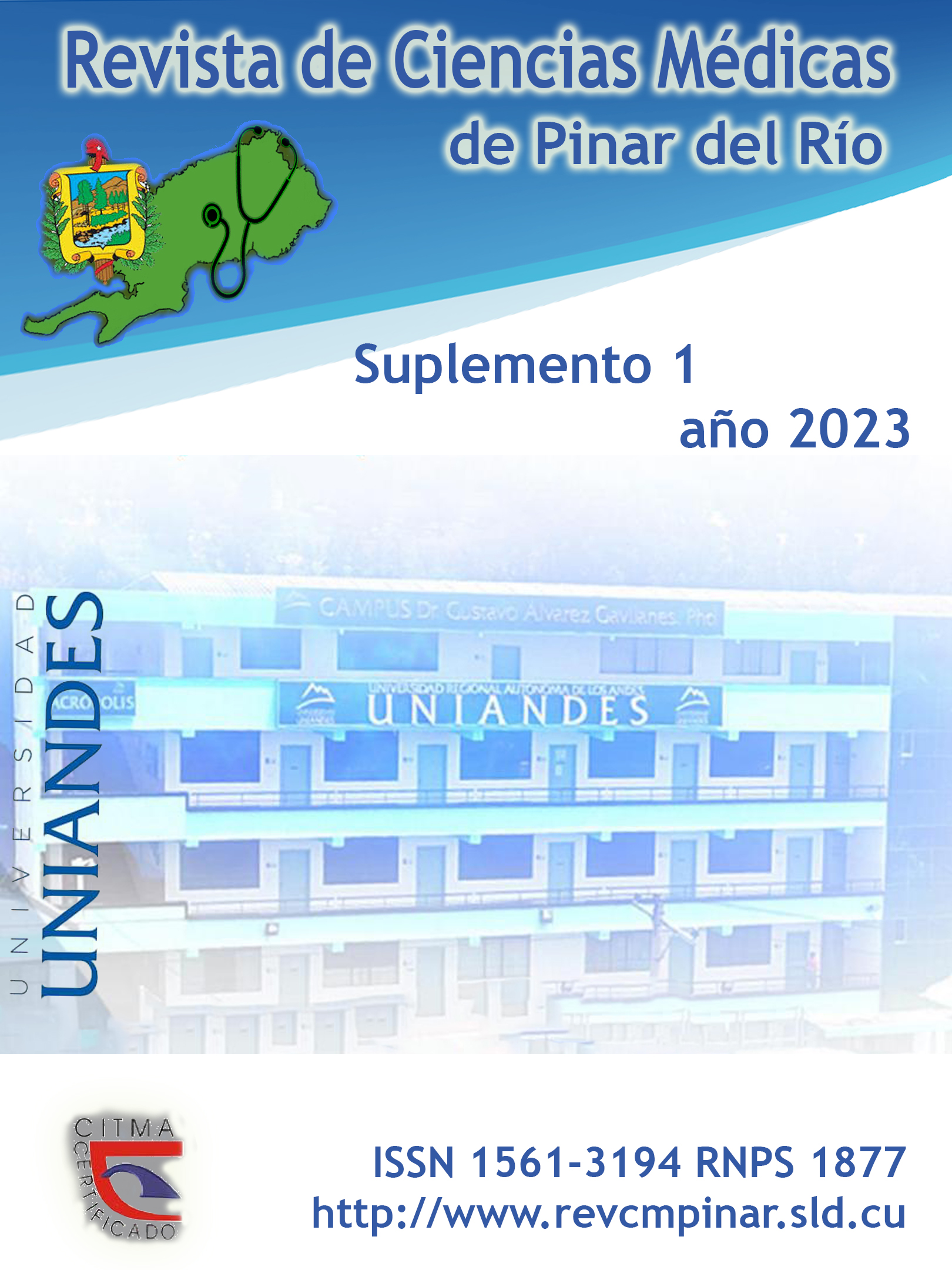Temporomandibular joint dysfunction in patients post orthodontic treatment
Keywords:
TEMPOROMANDIBULAR JOINT, ORTHODONTICS, DENTAL OCCLUSION, OROFACIAL.Abstract
Introduction: possible temporomandibular disorders that may occur after an orthodontic procedure are more common than has been investigated.
Objective: To determine the correlation between orthodontics and temporomandibular joint (TMJ) dysfunctions in patients aged 14-22 years.
Methods: An observational, descriptive and cross-sectional study was conducted to determine the correlation between orthodontics and temporomandibular joint (TMJ) dysfunctions in patients between 14 and 22 years of age, Santo Domingo, Ecuador, in the period 2020 - 2022. The universe consisted of 63 patients, the sample obtained by simple random sampling and the inclusion-exclusion criteria consisted of 42 patients.
Results: 63,28 % of the study population was female and 36,62 % was male. Fifty-four percent of the patients surveyed had little pain, 32 % reflected in the surveys that their pain was mild and only 9 % had severe pain. Thirty-six per cent of the patients reported that they never felt their jaw "locked" and 37 % rarely.
Conclusions: orthodontics is not the definitive treatment for temporomandibular disorders; there is a relationship between them and orthodontics, yes, but it is a treatment for very specific cases, where temporomandibular disorders are caused by malocclusion. For disorders of other origin, another type of treatment or a mixture of several of these is necessary.
Downloads
References
1. Stoll ML, Kau CH, Waite PD, Cron RQ. Temporomandibular joint arthritis in juvenile idiopathic arthritis, now what? Pediatric Rheumatology[Internet]. 2018[cited 01/03/2023]; 16(1). Available from: http://dx.doi.org/10.1186/s12969-018-0244-y
2. Murphy MK, MacBarb RF, Wong ME, Athanasiou KA. Temporomandibular Joint Disorders: A Review of Etiology, Clinical Management, and Tissue Engineering Strategies. Int J Oral Maxillofac Implants[Internet]. 2013 Nov.-Dic[cited 01/03/2023]; 28(6): e393-e414. Available from: https://www.ncbi.nlm.nih.gov/pmc/articles/PMC4349514/
3. Gauer RL, Semidey MJ. Diagnosis and treatment of temporomandibular disorders. AFP [Internet]. 2015 [cited 01/03/2023]; 91(6): 378–86. Available from: https://www.aafp.org/pubs/afp/issues/2015/0315/p378.html
4. Crespo Peréz M. Trastornos de la articulación temporomandibular, tratamientos fisioterapéuticos una revisión sistemática[Internet]. 2021 [cited 01/03/2023]. Repositori URV. Ciències de la salut Health sciences Ciencias de la salud. Available from: https://repositori.urv.cat/estatic/TFG0011/en_TFG3550.html
5. Bush PG, Williams AJ. Incidence of the Robin Anomalad (Pierre Robin syndrome). Br J Plast Surg [Internet]. 1983 [cited 01/03/2023]; 36(4): 434–7. Available from: https://www.jprasurg.com/article/0007-1226(83)90123-6/pdf
6. Michelotti A, Rongo R, D’Antò V, Bucci R. Occlusion, orthodontics, and temporomandibular disorders: Cutting edge of the current evidence. J World Fed Orthod [Internet]. 2020[cited 01/03/2023]; 9(3 Supl): S15–S18. Available from: https://www.sciencedirect.com/science/article/pii/S2212443820300436
7. Michelotti A, Iodice G. The role of orthodontics in temporomandibular disorders. J Oral Rehabil [Internet]. 2010[cited 01/03/2023]; 37(6): 411–29. Available from: http://dx.doi.org/10.1111/j.1365-2842.2010.02087.x
8 García S, Vanessa D. Alto rendimiento en deportistas: boxeo, y su relación con trastornos de la articulación temporomandibular. concentración deportiva de Pichincha. Periodo Marzo-Junio 2015. Quito: UCE; 2015.
9. Villar C, Jeremy M. Tratamiento en pacientes con disfunción temporomandibular; 2021.
10. Gil-Martinez A, Paris-Alemany A, López-de-Uralde-Villanueva I, La Touche R. Management of pain in patients with temporomandibular disorder (TMD): challenges and solutions. J Pain Res [Internet]. 2018 [cited 01/03/2023]; 11: 571–87. Available from: http://dx.doi.org/10.2147/jpr.s127950
11.Armijo-Ikuvo S, Oitance L, Singh V, Neto F; Thie N, Michelotti A. Effectiveness of Manual Therapy and Therapeutic Exercise for Temporomandibular Disorders: Systematic Review and Meta-Analysis [Internet]. Physical Therapy. 2016 [cited 01/03/2023]; 96(1): 9-25 Available from: https://academic.oup.com/ptj/article/96/1/9/2686339?login=false
12. Santana MR, Grau León IB, Chala YM, Salso Morell RA. Evaluación de un protocolo para el diagnóstico y tratamiento de los trastornos inflamatorios temporomandibulares. Revista Electrónica Dr. Zoilo E. Marinello Vidaurreta [Internet]. 2015 [citado 01/03/2023]; 40(5). Disponible en: https://revzoilomarinello.sld.cu/index.php/zmv/article/view/64
13. Vélez Uribe JD, Vélez LC, Pérez Mejía M, Barragán KA. Síndrome de disfunción de la articulación temporomandibular y el papel de la educación en su tratamiento[Internet]. CES Movimiento y Salud. 2015 [citado 01/03/2023]; 3(1): 44-52. Disponible en: https://revistas.ces.edu.co/index.php/movimientoysalud/article/view/3352
14. Luther F. Orthodontics and the temporomandibular joint: Where are we now? Part 1. Orthodontic treatment and temporomandibular disorders [Internet]. 1998[citado 01/03/2023]; 68(4): 295-304. Available from: https://meridian.allenpress.com/angle-orthodontist/article/68/4/295/57194/Orthodontics-and-the-temporomandibular-joint-Where
Downloads
Published
How to Cite
Issue
Section
License
Authors who have publications with this journal agree to the following terms: Authors will retain their copyrights and grant the journal the right of first publication of their work, which will be publication of their work, which will be simultaneously subject to the Creative Commons Attribution License (CC-BY-NC 4.0) that allows third parties to share the work as long as its author and first publication in this journal are indicated.
Authors may adopt other non-exclusive license agreements for distribution of the published version of the work (e.g.: deposit it in an institutional telematic archive or publish it in a volume). Likewise, and according to the recommendations of the Medical Sciences Editorial (ECIMED), authors must declare in each article their contribution according to the CRediT taxonomy (contributor roles). This taxonomy includes 14 roles, which can be used to represent the tasks typically performed by contributors in scientific academic production. It should be consulted in monograph) whenever initial publication in this journal is indicated. Authors are allowed and encouraged to disseminate their work through the Internet (e.g., in institutional telematic archives or on their web page) before and during the submission process, which may produce interesting exchanges and increase citations of the published work. (See The effect of open access). https://casrai.org/credit/



